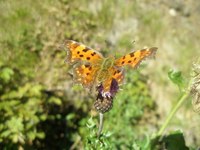Biodiversity
The term 'biodiversity' includes all forms and organizational levels of the living world. The concept thus goes far beyond 'the number of species which can be found in a given area'. It also includes the diversity of species communities and ecosystems as well as genetic diversity among individuals of the same species. In the simplest case, the different entities - e.g. genotypes, species, habitat types etc. - are merely counted, and the number of entities gives a measure of diversity. In addition, there are methods to calculate diversity indices that take into account the relative abundance of the different entities. The more evenly the relative abundance is distributed among them, the higher the value of the diversity index gets. If, by contrast, only a small number of entities is very abundant and the majority are rare, the index value declines even if the total number of entities remains unchanged.
In scientific analyses the diversity found in a single site is distinguished from the diversity across sites. The first type is called alpha-diversity, whereas the second is referred to as beta-diversity. Beta-diversity is a measure for the similarity e.g. of the species composition or the composition of habitat types in different sites. The concepts of alpha- and beta-diversity are of great practical relevance e.g. for the planning of nature reserves.
Investigations of the functional aspects of biodiversity are a fairly new and very active area of research. The fundamental question in this context is to what extent the number or relative abundance of species or functional types of organisms influences ecological processes. There is evidence that e.g. productivity and stability of communities can increase with increasing diversity. Such findings are relevant also for the sustainable use of ecosystems in cultural landscapes.
 |
 |
 |
